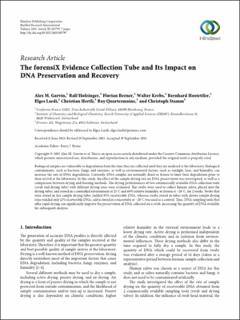Please use this identifier to cite or link to this item:
https://doi.org/10.21256/zhaw-1433| Publication type: | Article in scientific journal |
| Type of review: | Peer review (publication) |
| Title: | The forensiX evidence collection tube and its impact on DNA preservation and recovery |
| Authors: | Garvin, Alex M. Holzinger, Ralf Berner, Florian Krebs, Walter Hostettler, Bernhard Lardi, Elges Hertli, Christian Quartermaine, Roy Stamm, Christoph Georg |
| DOI: | 10.21256/zhaw-1433 10.1155/2013/105797 |
| Published in: | BioMed Research International |
| Volume(Issue): | 2013 |
| Issue Date: | Oct-2013 |
| Publisher / Ed. Institution: | Hindawi |
| ISSN: | 2314-6133 2314-6141 |
| Language: | English |
| Subject (DDC): | 572: Biochemistry |
| Abstract: | Biological samples are vulnerable to degradation from the time they are collected until they are analysed at the laboratory. Biological contaminants, such as bacteria, fungi, and enzymes, as well as environmental factors, such as sunlight, heat, and humidity, can increase the rate of DNA degradation. Currently, DNA samples are normally dried or frozen to limit their degradation prior to their arrival at the laboratory. In this study, the effect of the sample drying rate on DNA preservation was investigated, as well as a comparison between drying and freezing methods. The drying performances of two commercially available DNA collection tools (swab and drying tube) with different drying rates were evaluated. The swabs were used to collect human saliva, placed into the drying tubes, and stored in a controlled environment at 25°C and 60% relative humidity, or frozen at −20°C, for 2 weeks. Swabs that were stored in fast sample drying tubes yielded 95% recoverable DNA, whereas swabs stored in tubes with slower sample drying rates yielded only 12% recoverable DNA; saliva stored in a microtube at −20°C was used as a control. Thus, DNA sampling tools that offer rapid drying can significantly improve the preservation of DNA collected on a swab, increasing the quantity of DNA available for subsequent analysis. |
| URI: | https://digitalcollection.zhaw.ch/handle/11475/10453 |
| Fulltext version: | Published version |
| License (according to publishing contract): | CC BY 3.0: Attribution 3.0 Unported |
| Departement: | Life Sciences and Facility Management |
| Organisational Unit: | Institute of Chemistry and Biotechnology (ICBT) |
| Appears in collections: | Publikationen Life Sciences und Facility Management |
Files in This Item:
| File | Description | Size | Format | |
|---|---|---|---|---|
| 2013_Garvin_The_forensiX_Evidence_Collection_Tube_and_its_Impact.pdf | 1.64 MB | Adobe PDF |  View/Open |
Show full item record
Garvin, A. M., Holzinger, R., Berner, F., Krebs, W., Hostettler, B., Lardi, E., Hertli, C., Quartermaine, R., & Stamm, C. G. (2013). The forensiX evidence collection tube and its impact on DNA preservation and recovery. BioMed Research International, 2013. https://doi.org/10.21256/zhaw-1433
Garvin, A.M. et al. (2013) ‘The forensiX evidence collection tube and its impact on DNA preservation and recovery’, BioMed Research International, 2013. Available at: https://doi.org/10.21256/zhaw-1433.
A. M. Garvin et al., “The forensiX evidence collection tube and its impact on DNA preservation and recovery,” BioMed Research International, vol. 2013, Oct. 2013, doi: 10.21256/zhaw-1433.
GARVIN, Alex M., Ralf HOLZINGER, Florian BERNER, Walter KREBS, Bernhard HOSTETTLER, Elges LARDI, Christian HERTLI, Roy QUARTERMAINE und Christoph Georg STAMM, 2013. The forensiX evidence collection tube and its impact on DNA preservation and recovery. BioMed Research International. Oktober 2013. Bd. 2013. DOI 10.21256/zhaw-1433
Garvin, Alex M., Ralf Holzinger, Florian Berner, Walter Krebs, Bernhard Hostettler, Elges Lardi, Christian Hertli, Roy Quartermaine, and Christoph Georg Stamm. 2013. “The forensiX Evidence Collection Tube and Its Impact on DNA Preservation and Recovery.” BioMed Research International 2013 (October). https://doi.org/10.21256/zhaw-1433.
Garvin, Alex M., et al. “The forensiX Evidence Collection Tube and Its Impact on DNA Preservation and Recovery.” BioMed Research International, vol. 2013, Oct. 2013, https://doi.org/10.21256/zhaw-1433.
Items in DSpace are protected by copyright, with all rights reserved, unless otherwise indicated.